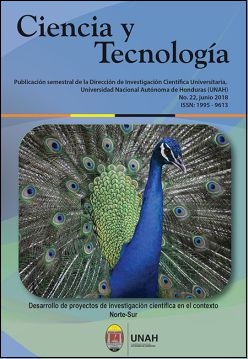Geohelmintiasis and hyper-IgE in schoolchildren of a rural area and an urban area of Honduras between September 2014 to June 2015
DOI:
https://doi.org/10.5377/rct.v0i22.6445Keywords:
helminths, IgEAbstract
Introduction: Helminths transmitted by the soil (geohelminths) are the intestinal parasites that provoke the polarization of the immune system towards a response characterized by the high circulating values of Immunoglobulin E (IgE). In Honduras, there are no recent studies demonstrating this biological phenomenon.
Objectives: This study aims to determine the association between geohelminth infections with hyper- IgE, comparing schoolchildren from a rural area and an urban area of Honduras.
Methodology: Descriptive transversal study. Two communities were selected, with a high prevalence of geohelminths (> 50%) and an urban with low prevalence of geohelminths (<20%). Interviews were conducted with the participants to determine their age, grade and history of deworming. To determine the prevalence of parasites, faecal samples were collected and processed with the Kato-Katz Method and Ethyl Acetate. To determine serum IgE levels, blood samples were taken, and the serum was processed using MagPIX® technology (human Bio-Plex Pro_IgE kit). According to this method the limit of detection for IgE is 0.040 ng / ml. Ethical approval CEI/MEIZ. Parametric and non-parametric statistical analysis.
Results: 73 children from the rural area and 71 from the urban area were studied, of which 35 (47.9%) and 5 (7%) were parasitized with one or more species of geohelminths (Trichuris trichiura, Ascaris lumbricoides, hookworm) respectively. Eight participants (<6%) had moderate to severe infections. The rural population presented 94.5% (69) of hyper-IgE in contrast to the urban population with 63.5% (45), (p <0.001). Limitations: there is no history of allergic processes related to IgE.
Conclusions: This study was able to determine that there is a significant difference in the IgE levels of children with geohelminth parasites between rural and urban populations. This may explain the decline in allergic reactions in older populations.
Downloads
1336
Downloads
Published
How to Cite
Issue
Section
License
© Revista Ciencia y Tecnología
Authors who publish in this journal accept the following conditions: In accordance with the legislation of copyright, Revista Ciencia y Tecnología, recognizes and respects the moral right of authors, as well as the ownership of the patrimonial right, which will be ceded to the magazine for its diffusion in open access in printed version and in digital format. By being part of multiple indexers, databases and reference systems, the articles published by Revista Ciencia y Tecnología will be visible and will be downloaded from these websites, indicating, in all cases, the authorship of the articles, the date of publication and the number of the journal to which they correspond.




